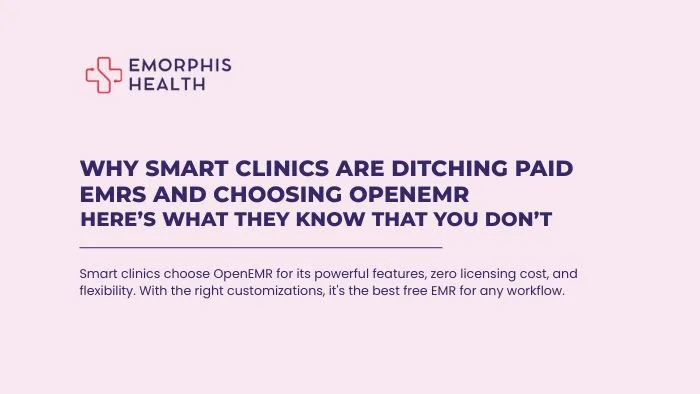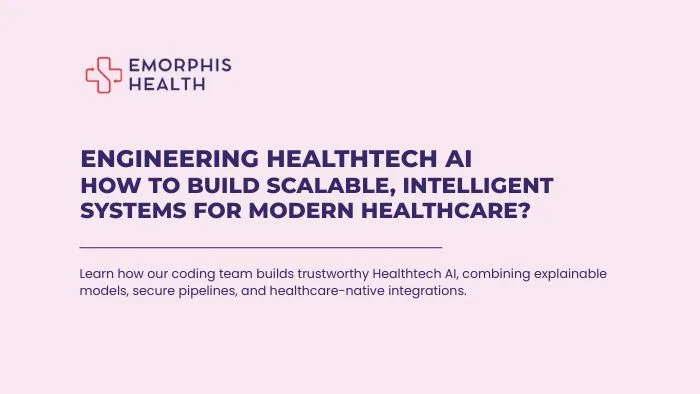Introduction – Fundamental aspects of digital transformation in healthcare
See Contents
- 1 Introduction – Fundamental aspects of digital transformation in healthcare
- 2 Key Drivers of Digital Transformation in Healthcare
- 3 Challenges in Healthcare Digital Transformation
- 4 Strategic Planning for Seamless Digital Transformation
- 5 Technological Enablers in Healthcare Digital Transformation, The Pillars of Change
- 6 Conclusion
In an age where bytes of information have become as crucial as the pulse, healthcare is undergoing a profound metamorphosis. The canvas of patient care is no longer confined to traditional methodologies but has expanded into the realms of digital transformation. This article serves as a compass for digital transformation in healthcare helping to navigate the intricate landscape of healthcare’s digital revolution. Moreover unraveling the fundamental aspects that define this transformative journey.
According to a report by Statista, in 2022, the global digital health market achieved a noteworthy valuation of over 330 billion U.S. dollars. Building on this momentum, the market continued to grow, reaching 417 billion dollars in 2023. Projections for the coming years are even more substantial, with forecasts suggesting that by 2025, the digital health market will surpass an impressive 650 billion dollars. This upward trajectory underscores the sector’s robust expansion, driven by the widespread adoption of digital technologies in healthcare. From telemedicine to health information systems and wearable devices, the dynamic evolution of digital health is playing a pivotal role in reshaping and enhancing healthcare practices worldwide.
Defining Digital Transformation in Healthcare
Digital transformation in healthcare transcends mere adoption of technology; it’s a holistic reimagining of how healthcare is conceptualized, delivered, and experienced. At its core, it involves leveraging cutting-edge technologies to enhance patient care, streamline processes, and propel the entire industry into a new era of efficiency and innovation.
The Significance of Digital Transformation
The significance of this digital metamorphosis cannot be overstated. It’s not merely about embracing technology for the sake of modernization; it’s about ushering in a new era of patient-centric, data-driven healthcare. Digital transformation equips healthcare providers with the tools to deliver personalized, timely, and efficient care while empowering patients to actively participate in their well-being.
Exploring the Evolution of Healthcare in the Digital Age
As we embark on this transformative journey, it’s essential to trace the evolution of healthcare in the digital age. From the humble beginnings of electronic health records (EHRs) to the interconnected ecosystem of telehealth, artificial intelligence (AI), and the Internet of Things (IoT), every technological stride has shaped a new facet of healthcare delivery.
Digital advancements have not only enhanced the efficiency of healthcare processes but have also redefined the doctor-patient relationship. The dynamic exchange of information, the emergence of virtual care platforms, and the integration of AI in diagnostics are rewriting the narrative of how healthcare is perceived and experienced.
Join us on this journey as we unlock the potential of digital transformation in healthcare, navigating the challenges, embracing innovations, and paving the way for a future where healthcare is not just a practice but a digital symphony of well-being.
Key Drivers of Digital Transformation in Healthcare
In the realm of healthcare, the winds of change are blowing, steering the industry towards an era defined by digital transformation. Understanding the key drivers of this transformative journey is paramount in comprehending the monumental shifts taking place. Let’s navigate through the forces propelling this paradigm shift towards a digitally driven landscape.
1. Technological Advances: A Catalyst for Change
Digital transformation in healthcare is, in many ways, synonymous with technological evolution. Technological advances serve as the cornerstone, reshaping the very fabric of healthcare delivery and patient outcomes. The landscape is continually evolving, with innovations such as telehealth, Artificial Intelligence (AI), and the Internet of Things (IoT) paving the way for a new era of accessible, efficient, and patient-centric care.
Moreover, these technological marvels extend beyond the clinical realm, influencing how patients engage with healthcare services. Mobile applications, wearable devices, and other digital tools have become integral components in managing health, creating a more interconnected and engaged healthcare ecosystem.
Check out the latest Healthcare Trends reshaping the industry.
2. Changing Patient Expectations: A Shifting Landscape
In the digital age, patient expectations are evolving, and healthcare services are adapting in response. Patients now seek a more personalized, accessible, and convenient healthcare experience. Moreover, the shift is not only about receiving medical care but also about being active participants in their wellness journey.
Patients are increasingly relying on digital platforms to access health information, schedule appointments, and even participate in shared decision-making processes. This expectation shift is a driving force propelling healthcare organizations to adopt digital solutions that cater to the modern patient’s needs and preferences.
find the details on Leveraging Cloud Solutions in Healthcare for Streamlined Patient Care
3. Regulatory and Policy Initiatives: Navigating Compliance in the Digital Era
In the ever-changing landscape of healthcare, regulations, and policies play a pivotal role in shaping the trajectory of digital transformation. Investigating the intricate web of compliance and ethical considerations becomes crucial as healthcare organizations embark on their digital journey.
However, these regulations, far from being restrictive, act as guiding beacons. They ensure that the digital transformation journey aligns with ethical standards, patient privacy, and data security. Moreover, compliance fosters an environment of trust, assuring both patients and stakeholders that the digital evolution is conducted with the highest standards of integrity.
Learn more about the regulations and Healthcare Compliance governing healthcare software
4. Data-driven Decision Making: Harnessing the Power of Information
In the heart of healthcare digital transformation beats the pulse of data-driven decision making. The pivotal role of data cannot be overstated, as it serves as the lifeblood that fuels strategic decisions and shapes the future of healthcare practices.
In fact, data-driven insights empower healthcare professionals to make informed decisions, enhance patient outcomes, and optimize operational processes. Whether it’s analyzing patient trends, improving treatment protocols, or predicting disease outbreaks, the integration of data into decision-making processes is a cornerstone of the digital revolution in healthcare.
Explore How Integrated Health Solutions helps in advancing healthcare delivery.
Overall, the key drivers of digital transformation in healthcare intertwine seamlessly, creating a narrative of evolution, adaptation, and empowerment. As we explore these drivers, we embark on a journey where technology, patient expectations, regulations, and data converge to reshape the very essence of healthcare delivery.
Challenges in Healthcare Digital Transformation
As we traverse the landscape of digital transformation in healthcare, it is crucial to acknowledge and address the challenges that organizations encounter on this transformative journey. These hurdles, though formidable, are the crucible in which the future of healthcare is being forged.
a. Interoperability Issues: Bridging the Digital Divide
Healthcare Interoperability stands as both a beacon and a hurdle in the digital transformation journey. Identifying the challenges related to interoperability and data exchange among different healthcare systems and platforms is paramount. Despite the digital advancements, healthcare systems often operate in silos, impeding the seamless flow of patient information between entities. However, overcoming these interoperability challenges is the key to creating a cohesive digital ecosystem that benefits providers and patients.
b. Data Security and Privacy Concerns: Safeguarding the Digital Realm
Delving into the digital realm, data security and privacy concerns emerge as critical issues that demand meticulous attention. The wealth of healthcare data circulating in the digital landscape is a treasure trove for improving patient care, but it also poses significant risks. Ensuring the confidentiality and integrity of healthcare data is not only a regulatory requirement but a fundamental responsibility. As we explore these concerns, we unravel the complexities of safeguarding sensitive healthcare information in the interconnected world of digital healthcare.
c. Resistance to Change: Nurturing a Culture of Innovation
Discussing the human aspect of digital transformation unveils a multifaceted challenge—resistance to change among healthcare professionals and stakeholders. In fact, the cultural shift required to embrace digital transformation is often met with apprehension and reluctance. Overcoming this resistance demands a strategic approach that includes education, training, and fostering a culture that embraces innovation. The synergy between human expertise and technological advancement is pivotal in steering healthcare toward a digital future.
d. Financial Implications: Balancing Innovation and Resources
Analyzing the financial considerations and implications associated with adopting and implementing digital transformation initiatives in healthcare brings us face-to-face with a practical challenge. The digital revolution requires investments in technology, training, and infrastructure. However, this financial commitment is not without its complexities. Striking a balance between innovation and resource allocation is critical. It involves crafting a financial roadmap that aligns with organizational goals while ensuring sustainability and long-term success.
In essence, addressing these challenges is not just a necessity; it’s a strategic imperative. As we confront interoperability hurdles, fortify data security, navigate resistance to change, and manage financial implications, we pave the way for a healthcare landscape that seamlessly integrates digital advancements into its very fabric. Each challenge, when met with strategic solutions, becomes a stepping stone towards a future where healthcare is not just digital but profoundly transformative.
Strategic Planning for Seamless Digital Transformation
Having navigated through the challenges, it’s time to delve into the strategic planning that underpins a successful digital transformation in healthcare. This section is the compass, guiding healthcare organizations through the intricate process of planning and executing a seamless transition into the digital future.
i. Establishing a Clear Vision and Objectives: The North Star of Transformation
Defining the vision and objectives becomes the North Star that guides healthcare organizations in their digital transformation efforts. In essence, a clear vision acts as the driving force, aligning all stakeholders towards a common goal. Moreover, well-defined objectives serve as milestones, marking the progress on the transformative journey. In fact, establishing this clear direction ensures that every digital initiative contributes to the overarching mission of enhancing patient care and operational efficiency.
ii. Building Cross-functional Teams: The Collaborative Backbone
Highlighting the importance of collaborative, cross-functional teams becomes paramount in driving successful digital transformation projects. In fact, the synergy between diverse skill sets—clinicians, IT professionals, and administrators—fuels innovation and problem-solving. Moreover, these teams bridge the gap between technology and healthcare expertise, ensuring that digital initiatives align with the needs of both healthcare professionals and patients.
iii. Assessing Current Technological Infrastructure: Foundations for Transformation
Evaluating the existing technological landscape is akin to laying the foundations for a digital transformation. This step involves a comprehensive analysis, identifying areas for improvement and optimization in the digital transformation process. Additionally, understanding the strengths and limitations of the current infrastructure informs strategic decisions on technology adoption, ensuring seamless integration and efficiency gains.
iv. Budgeting and Resource Allocation: Financial Prudence in Transformation
Discussing the financial aspects of digital transformation, including budgeting and effective resource allocation, is a critical step in ensuring the sustainability of the initiative. In fact, financial prudence involves striking a balance between innovation and fiscal responsibility. Careful budgeting ensures that resources are allocated efficiently, optimizing the return on investment and fostering a culture of financial sustainability.
Find details about Healthcare Software Development and Healthcare Integrations Services to innovate healthcare delivery in the future.
Now, let us find the technology tools that are helping in digital transformation in healthcare.
Technological Enablers in Healthcare Digital Transformation, The Pillars of Change
Embarking on the journey of healthcare digital transformation unveils a landscape where technological enablers emerge as the steadfast pillars, reshaping the very foundations of how healthcare is delivered, managed, and experienced. These enablers are not mere tools; they are transformative forces that propel the industry into an era defined by connectivity, precision, and patient-centric care. Let’s explore each of these pillars, intricately woven into the fabric of healthcare’s digital evolution.
1. Electronic Health Records (EHRs) and Health Information Exchange (HIE): Streamlining Data Management
Imagine a seamless flow of health information, effortlessly accessible, and securely shared among healthcare providers. This vision comes to life through Electronic Health Records (EHRs) and Health Information Exchange (HIE). EHRs serve as comprehensive digital archives, capturing a patient’s entire medical history, diagnoses, treatments, and outcomes. When coupled with HIE, these enablers foster interoperability, ensuring that critical health data transcends organizational boundaries. The result is a streamlined, unified approach to data management that enhances care coordination, reduces redundancies and empowers healthcare professionals with a holistic view of each patient’s health journey.
Connect with us for EMR and EHR Integration Services
2. Telehealth and Remote Patient Monitoring: Transforming Patient Care
Picture a scenario where healthcare knows no geographical boundaries, where patients can receive expert medical advice without leaving their homes. Telehealth and Remote Patient Monitoring redefine patient care by breaking down barriers to access. These enablers bring healthcare directly to the patient’s doorstep through virtual consultations and real-time monitoring of vital signs. Beyond geographical accessibility, they enable continuous monitoring of chronic conditions, fostering early intervention and personalized care plans. The transformative impact lies not only in inconvenience but in the potential to revolutionize healthcare delivery, making it proactive, preventive, and patient-centric.
Check our Remote Patient Monitoring Software Development Services
3. Artificial Intelligence (AI) and Machine Learning (ML) in Diagnostics and Treatment: Revolutionizing Healthcare Practices
Step into a realm where machines analyze complex medical data with unparalleled speed and accuracy, guiding diagnostics and treatment decisions. Artificial Intelligence (AI) and Machine Learning (ML) redefine the landscape of healthcare practices. These enablers excel in pattern recognition, enabling faster and more precise diagnostics. From predicting disease outcomes to personalizing treatment plans based on individual patient data, AI and ML usher in an era where healthcare becomes not just reactive but predictive and personalized. The potential for medical breakthroughs and treatment innovations is boundless, offering a glimpse into a future where technology becomes an indispensable partner in the healing process.
4. Internet of Things (IoT) Applications in Healthcare: Connecting the Digital Dots
Envision a healthcare ecosystem where medical devices, wearables, and facilities communicate seamlessly, creating a network of interconnected data points. Internet of Things (IoT) Applications in Healthcare establish this interconnectedness, transforming the delivery of care. From smart medical devices that monitor vital signs to interconnected hospital infrastructure that optimizes resource utilization, IoT applications foster a real-time, data-driven healthcare environment. This connectivity not only enhances patient care but also facilitates predictive maintenance, ensuring the operational efficiency of healthcare facilities.
Click the link to get the answer to How IoT is Boosting Healthcare Application Development
5. Health Apps and Mobile Health (mHealth): Empowering Patient Engagement
Enter a world where healthcare is not confined to clinical settings but extends into the palms of patients’ hands. Health Apps and Mobile Health (mHealth) empower patients to actively engage in their well-being. From monitoring health metrics to accessing personalized health information, these enablers foster a continuous, patient-driven approach to healthcare. Patient engagement becomes a two-way street, with healthcare providers leveraging mobile platforms to deliver timely information, facilitate communication, and encourage active participation in treatment plans. The result is an empowered and informed patient population, contributing to improved health outcomes.
Check our Healthcare app development services
6. Cloud Computing in Healthcare: Enabling Scalability and Collaboration
Imagine a secure, scalable, and collaborative digital space where healthcare data is stored, accessed, and shared seamlessly. Cloud Computing in Healthcare is the enabler that transforms this vision into reality. The cloud provides a flexible and scalable infrastructure that transcends the limitations of traditional data storage. It facilitates accessibility to health information from anywhere, at any time, fostering collaboration among healthcare professionals and enabling data-driven decision-making. The cloud becomes the backbone of a dynamic and interconnected healthcare ecosystem, driving efficiency, innovation, and collaboration.
7. Cybersecurity Solutions for Healthcare: Safeguarding the Digital Realm
In the digital age, where information is a cornerstone of healthcare, ensuring the security and integrity of this data becomes paramount. Healthcare Cybersecurity emerges as the guardian of the digital realm, protecting healthcare systems and patient data from cyber threats. These enablers encompass specialized tools, protocols, and robust security measures that fortify the digital infrastructure. The result is an environment where patient confidentiality is sacrosanct, and healthcare organizations operate with the assurance that sensitive data remains secure against evolving cyber threats.
8. Wearable Health Devices: Pioneering Continuous Monitoring
Step into a world where health isn’t monitored intermittently during clinical visits but is a continuous, real-time endeavor. Wearable Health Devices or digital health solutions including smartwatches and fitness trackers, pioneer continuous monitoring by collecting and transmitting health-related data. These enablers bridge the gap between clinical care and daily life, offering insights into physical activity, vital signs, and overall well-being. The result is a paradigm shift towards proactive and preventive healthcare, where individuals are empowered with the tools to monitor and manage their health in real time.
9. Robotic Process Automation (RPA) in Healthcare: Enhancing Efficiency and Reducing Errors
Picture a healthcare environment where routine and repetitive tasks are automated, freeing up valuable human resources for more meaningful and complex endeavors. Robotic Process Automation (RPA) in Healthcare is the enabler that transforms this vision into reality. These enablers involve the deployment of robots and software bots to automate administrative and operational tasks. The result is heightened efficiency, reduced errors, and an optimized healthcare workflow that allows healthcare professionals to focus on patient care and complex decision-making.
10. 3D Printing in Healthcare: Revolutionizing Personalized Care
Enter the era of precision medicine with 3D Printing in Healthcare as the innovative enabler. This technology allows the creation of personalized, patient-specific implants, prosthetics, and even organs. The potential for customization extends beyond treatment to surgical planning. As a matter of fact, enabling healthcare professionals to tailor interventions to the unique anatomy of each patient. 3D Printing stands as a testament to the evolving landscape of healthcare. Moreover, it is where technology seamlessly integrates with individual patient needs, creating a new dimension in personalized care.
In essence, these technological enablers stand as the pillars of change, reshaping healthcare into a dynamic, interconnected, and patient-centric ecosystem. Each pillar contributes a unique dimension, weaving a tapestry where data is a catalyst, technology is a partner, and patients are active participants in their health journey. As we navigate through these transformative forces, healthcare’s digital evolution becomes not just a destination but a continuous journey towards a future where technology and compassion harmonize for the betterment of patient care.
Conclusion
Concluding with a forward-looking perspective, we beckon healthcare organizations to embrace a mindset of continuous innovation in healthcare software development. The landscape is ever-evolving, and the journey forward involves navigating through the frontiers of AI-driven diagnostics. Also personalized medicine integrations, and the seamless synergy between healthcare professionals and advanced software solutions. As we stand at the intersection of healthcare and technology, the road ahead invites healthcare software engineers to lead the charge. Moreover, fostering a future where innovation becomes synonymous with enhanced patient care, optimized workflows, and unparalleled advancements in the healthcare ecosystem.
Now, as we wrap up, let’s keep our eyes on the future. There’s a lot cooler stuff to explore – smarter AI, personalized medicine, and even more ways tech can make healthcare awesome. So, let’s stay curious, keep trying new things, and make healthcare even better with tech!











